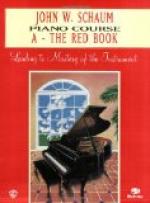Matthay listens to a complete performance of the work in hand, then turns back to the beginning and goes over it again for corrections and suggestions. He enters into it with absolute devotion, directing with movements of head and hands as a conductor might direct an orchestra; sometimes he dashes down a chord in the treble to urge more force; at other times lays a restraining hand on the player’s arm, where the tone should be softer. His blue pencil is often busy adding phrasing marks. In the pauses he talks over with the pupil the character of the piece, and the effects he thinks should be made. In short his lessons are most helpful and illuminating.
I also had the opportunity to attend a pupils’ “Practise Concert,” and here the results attained were little short of marvelous. Small children, both boys and girls, played difficult pieces, like the Grieg Variations for two pianos, the Weber Invitation to the Dance, and works by Chopin and Liszt, with accuracy and fluency. Almost every selection was played from memory. The tone was always musical and often of much power, and the pupils seemed thoroughly to understand what they were doing and the meaning of the music. They certainly exemplified the professor’s maxim:
“Never touch the piano without trying to make music.”
* * * * *
Not long afterward I received a copy of the new book, which had just come from the press. Its comprehensive title is Musical Interpretation, its Laws and Principles, and their Application in Teaching and Performing. The material was first presented in the form of lectures; on repeated requests it has been issued in book form. The author at the outset claims no attempt to treat such a complex problem exhaustively; he has, however, selected the following seven points for elucidation:
1. The difference between Practise and Strumming. 2. The difference between Teaching and Cramming. 3. How one’s mind can be brought to bear on one’s work. 4. Correct ideas of Time and Shape. 5. Elements of Rubato and its application. 6. Elements of Duration and Pedaling and their application. 7. Some details as to the application of the Element of Tone-variety.
Such themes must cause the thoughtful reader to pause and think. They are treated with illuminating originality. The great aim of the teacher must ever be to awaken thought along correct lines; the pupil must be assisted to concentrate his thought on what he is doing: to constantly think and listen. Teaching does not consist merely in pointing out faults; the teacher must make clear the cause of each fault and the way to correct it. That section of the book devoted to the Element of Rubato, is illustrated with many examples from well-known compositions, by which the principle is explained. He shows how frequently this principle is misunderstood by the inexperienced, who seem to think that rubato means breaking the time; whereas true rubato is the bending of the time, but not breaking it. If we give extra time to certain notes, we must take some time from other notes, in order to even things up.




